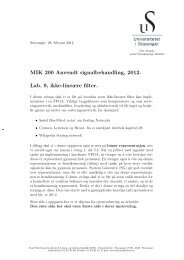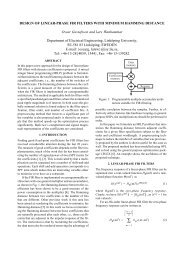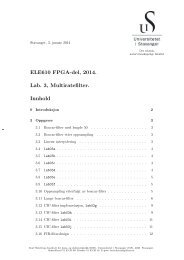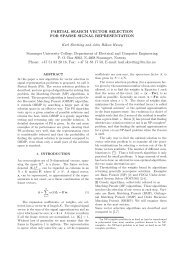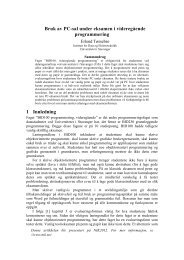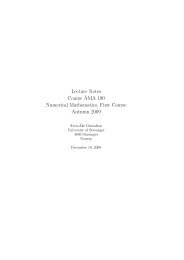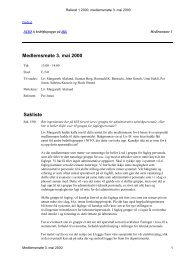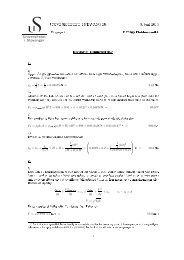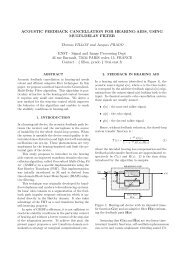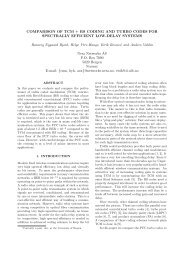Structural Geology Algorithms: Vectors and Tensors - Springer
Structural Geology Algorithms: Vectors and Tensors - Springer
Structural Geology Algorithms: Vectors and Tensors - Springer
Create successful ePaper yourself
Turn your PDF publications into a flip-book with our unique Google optimized e-Paper software.
Math GeosciDOI 10.1007/s11004-012-9433-2BOOK REVIEWRichard W. Allmendinger, Nestor Cardozo,<strong>and</strong> Donald M. Fisher: <strong>Structural</strong> <strong>Geology</strong> <strong>Algorithms</strong>:<strong>Vectors</strong> <strong>and</strong> <strong>Tensors</strong>New York: Cambridge University Press, 1st Edition,December 2011. Paperback ISBN 978-1-10-740138-9.302 pages. $50Rol<strong>and</strong> Bürgmann© International Association for Mathematical Geosciences 2012When I received the request by Mathematical Geosciences to review this book, I wasin the midst of teaching an upper-level undergraduate course in <strong>Structural</strong> <strong>Geology</strong><strong>and</strong> Tectonics. As is also the case in my graduate-level Active Tectonics course, studentsare expected to use linear algebra to evaluate stress <strong>and</strong> strain to gain first-orderunderst<strong>and</strong>ing of faulting <strong>and</strong> distributed deformation in the Earth. However, studentstaking these courses come with a wide range of, <strong>and</strong> often insufficient, priorknowledge <strong>and</strong> preparation in mathematics. Thus, I provide those students that askfor supplementary reading with a collection of copied book chapters <strong>and</strong> lecture notesfrom courses I have taken some time ago, always wishing that there were a compactbook that covered those topics relevant to geological <strong>and</strong> geophysical applications.This text entitled “<strong>Structural</strong> geology algorithms: vectors <strong>and</strong> tensors” is that longwished-forbook.In less than 300 pages, Richard Allmendinger <strong>and</strong> his colleagues Nestor Cardozo<strong>and</strong> Donald Fisher provide a unified treatment of linear algebra <strong>and</strong> computationalmethods starting from the basics. Not only does this text provide all the fundamentalconcepts needed in a wide range of mathematical operations used in structuralgeology <strong>and</strong> related fields, but it also provides short computer functions (in the accessible<strong>and</strong> widely used Matlab ® programming environment) to illustrate the underlyingalgorithms. While the book is focused on applications in structural geology,the material is relevant for students in other areas of geology <strong>and</strong> geophysics, includingmineralogy, seismology <strong>and</strong> geodesy. This book is meant to serve as a lab bookaccompanying an advanced course in structural geology, but I also strongly recommendthis book as a valuable basic resource for many Earth science students <strong>and</strong>professionals throughout their career.R. Bürgmann ()Department of Earth <strong>and</strong> Planetary Science, University of California, Berkeley, USAe-mail: burgmann@seismo.berkeley.edu
Math Geosci<strong>Structural</strong> geology is focused on the description <strong>and</strong> mechanical analysis of structuresin the lithosphere like faults, folds, fabrics, <strong>and</strong> other forms of localized <strong>and</strong>distributed deformation. <strong>Structural</strong> geologists seek efficient <strong>and</strong> quantitative characterization<strong>and</strong> visualization of the geometry of geologic structures, they hope to quantifythe strain experienced by deformed rocks, they aim to gain underst<strong>and</strong>ing of theforces that cause deformation, <strong>and</strong> they develop equations that describe the constitutiveproperties of rocks <strong>and</strong> faults. The mathematical framework for these efforts islinear algebra. <strong>Vectors</strong>, tensors <strong>and</strong> coordinate transformations underlie most of thegraphical methods <strong>and</strong> mathematical manipulations we employ to solve structuralgeology problems. Often students learn the mechanical operations employing thesemathematical principles in graphical methods (such as the manipulation of orientationdata on a stereonet or the construction of a graphical Mohr circle representationof stress or strain), but they do not underst<strong>and</strong> the underlying mathematical principles<strong>and</strong> calculations. This book provides this framework <strong>and</strong> the mathematical operationsneeded to apply linear algebra to structural geology problems.The best way to learn mathematical concepts <strong>and</strong> methods is to apply them in actualcomputations. Thus the book includes examples <strong>and</strong> exercises which often drawon short program functions provided in the text <strong>and</strong> online. Well-commented <strong>and</strong> easilydigested Matlab routines allow the student to follow <strong>and</strong> apply the mathematicaloperations <strong>and</strong> the functions that are easily modified <strong>and</strong> integrated to solve problems.The functions are drawn in part from programs written by the authors that arein wide use in the structural geology community. At least in my research group, wenow mostly rely on Matlab to solve problems <strong>and</strong> thus I appreciate the reliance onthis computing environment.The structure of the book is generally parallel to the treatment of topics in st<strong>and</strong>ardstructural geology textbooks, divided into 12 chapters. The first chapter previewsthe basic objectives <strong>and</strong> problem-solving needs in structural geology, including thedescription, visualization <strong>and</strong> quantification of geologic structures <strong>and</strong> their evolutiondue to deformation. The chapter also introduces linear algebra as the computationalframework to solve these problems <strong>and</strong> Matlab as the convenient computing syntaxto carry out related calculations. Spherical projections used to plot orientation data onstereonets <strong>and</strong> to develop projections that produce flat maps of the Earth’s sphericalsurface are explained in some detail. Finally, a detailed three-page table summarizesall the functions provided, where they appear in the book <strong>and</strong> how they relate to eachother. All remaining chapters are complemented by exercises allowing the student toapply what has been learned <strong>and</strong> deepen the underst<strong>and</strong>ing of the material.The next four chapters introduce the basic components of linear algebra in lessthan one hundred pages. Chapter 2 summarizes coordinate systems, scalars <strong>and</strong> vectors<strong>and</strong> how they can be used to represent geologic features. Chapter 3 introducestransformations (translations <strong>and</strong> rotations) of coordinate axes <strong>and</strong> vectors <strong>and</strong> theirrelevance to structural analysis. Chapter 4 illustrates the utility of matrix operations<strong>and</strong> notations in related computations. Indicial notations, summation conventions <strong>and</strong>elementary matrix operations are clearly <strong>and</strong> succinctly explained <strong>and</strong> accompaniedby code snippets carrying out the needed calculations. Chapters 2 through 4 developthe background for Chap. 5, which is dedicated to the concept of tensors, addingsecond-order tensors used to describe stress <strong>and</strong> strain <strong>and</strong> other physical quantities
Math Geoscito the already introduced lower order scalars <strong>and</strong> vectors. The nature of tensors, theirnotation, transformations <strong>and</strong> fundamental properties are efficiently explained <strong>and</strong>the important concept of eigenvalues <strong>and</strong> eigenvectors is introduced.Chapters 6 through 11 apply linear algebra to the treatment of stress <strong>and</strong> strainthat underlie much of structural geology. The three-dimensional state of stress is mosteasily understood as a tensor quantity <strong>and</strong> Chap. 6 provides a succinct treatment ofthe notation, transformations <strong>and</strong> applications used to evaluate stress. Many geologictextbooks introduce the Mohr circle as a somewhat magical graphical representationof the relationship of various stress components, while the underlying principles areso much easier explained when recognizing the tensor properties of stress. A detailedexploration of methods focused on deducing the state of stress from orientations offault <strong>and</strong> slip vector orientations serves as an illustrative example of the utility of tensortransformations. The next four chapters are devoted to the introduction of deformation,infinitesimal strain, finite strain, <strong>and</strong> progressive strain histories. Again, thesetopics are introduced in a succinct but comprehensive fashion that readers should appreciate.I particularly enjoyed the consideration of tectonic geodetic measurementsof deformation in this treatment, which includes an introduction to least-squares fittingof GPS displacement measurements <strong>and</strong> a nice pair of exercises exploring thedeformation field of a large subduction zone earthquake in Chile.Chapter 11 introduces the interesting <strong>and</strong> relatively complex problems associatedwith the development of kinematic models of tectonic deformation, with a focuson various types of models of fault-related folds, which is a research applicationfor which the authors have also written fully developed software programs availableto the research community (available at http://www.geo.cornell.edu/geology/faculty/RWA/programs/ <strong>and</strong> http://www.ux.uis.no/~nestor/work/programs.html).The final chapter deals with the very important topic of measurement uncertainties<strong>and</strong> error analysis. Unfortunately, following just two pages introducing this topic <strong>and</strong>introducing the propagation of errors, the reader is referred to other sources to learnmore about statistics <strong>and</strong> error analysis. Instead, the chapter focuses on the relativelyspecialized topic of uncertainties in balanced cross sections <strong>and</strong> one particular type offold–fault model introduced in Chap. 11. I suspect that most undergraduate studentswill not be able to follow this treatment <strong>and</strong> it would have been good to explorethe importance of how to formally treat uncertainty <strong>and</strong> errors in structural analysesfocusing on the more fundamental topics of stress <strong>and</strong> deformation introduced earlier.Maybe this can be considered for a future edition of this valuable text.The book is well crafted <strong>and</strong> relatively free of typos <strong>and</strong> errors. The authors haveposted an errata with some corrections at http://www.geo.cornell.edu/geology/faculty/RWA/structural-geology-algorith/.I highly recommend this book to all structural geology students <strong>and</strong> practitioners,as well as to earth scientists from a wide range of fields, who will benefit from thisclear introduction of the principles <strong>and</strong> application of linear algebra in the analysis ofcommonly encountered vector <strong>and</strong> tensor quantities.



